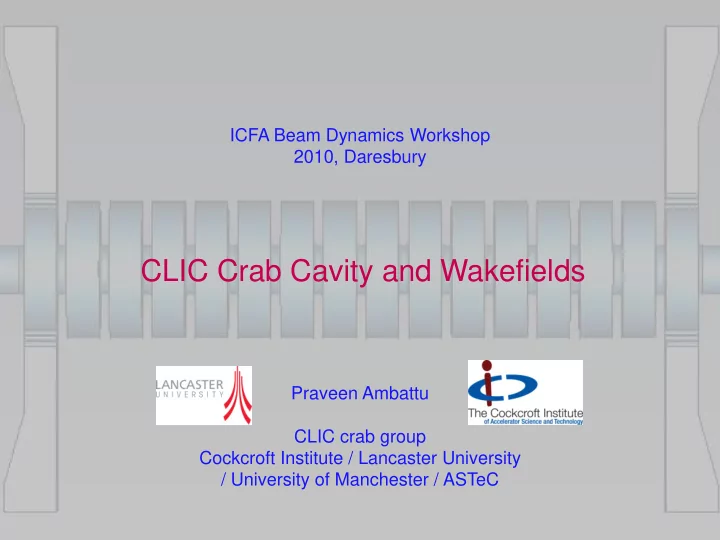

ICFA Beam Dynamics Workshop 2010, Daresbury CLIC Crab Cavity and Wakefields Praveen Ambattu CLIC crab group Cockcroft Institute / Lancaster University / University of Manchester / ASTeC
Crab Cavity Operation BDS chapter of the CLIC CDR, http://clicr.web.cern.ch/CLICr/MainBeam/BDS/CDR/TEX/
Technology choice High group velocity / TW cavity: - beam-loading correction - phase control , than SW cavity - a = 5 mm, v gr = 2.95 % 12 GHz cavity: - availability of X-band Klystron - kick per cavity - phase tolerance Heavily damped or moderately damped-detuned cavity: - Transverse and longitudinal wakefield
16 cell Crab Cavity P in =7.3 MW P out =6 MW V cav =2.55 MV E tr =18 MV/m P cav =1.19 MW P beam =117 kW
Wakefield effects in crab cavity Bunch(es) can excite a variety of modes with different properties • Lower order mode energy spread inefficient focus • Crab / operating mode beamloading amplitude error • Same order mode vertical deflection bunches miss at IP • Higher order modes (HOMs) both monopole and dipole contributions The most dangerous in the group is the SOM which has the same frequency and kick as the operating mode but in the vertical plane.
Multibunch wakefield in the undamped cavity, Q=6000 N 1 b W 2rK sin(n T )exp( nT / T ) Single mode-Multibunch-Transverse wake: m,t m,t m b b d n 1 Since the multi-bunch transverse wake field is a sum of sinusoidal oscillations, there are frequencies where the wakefield is essentially zero This happens at harmonics of half bunch frequency (n.1GHz, n=1,3, 5..), no need of any SOM damping iff the bunches are coming at the same offset from the axis 11 GHz 13 GHz 1 MHz off 1) Fixed offset for all bunches
2) Fixed offset and sign alternation bunch-to-bunch 12 GHz 14 GHz 10 GHz 3) Random offset and random sign Damping is essential !
Fixed offset and sign alternation bunch-to-bunch , Q=30 Tolerance Random offset and random sign, Q=30
The maximum longitudinal wake occurs at the bunch harmonic In the 12 GHz dipole cavity, the LOM occurs between 8.3 and 8.8 GHz which are far off-resonance Single mode-Multibunch-Longitudinal wake: N 1 b W K 1 2 cos(n T )exp( nT / T ) m,z m,z m b b d n 1 However, geometry modifications for damping dipole modes may shift the LOM also to resonance. So LOM damping is also essential
Damping tolerances o Transverse wake: Luminosity loss is under 2 % Tolerance: 0.3 V/pC, for a 16 cell cavity o Longitudinal wake: Bunch energy spread is under 1e-4%, Tolerance: 2500 V/pC for a 16 cell CC o Worst case Qs: Calculated at the frequency of maximum kick / loss factor Freq., df for max mode wake, MHz Q ext (x) Q ext (y) GHz Dipole modes (offset = 35 m m) 1 Dip1 11.9942 -- 33 2 Dip3 24.0663 225 211 2.14 Dip4 25.634 457 429 2.74 Dip6 32.8852 611 572 Monopole modes (offset = 0) 668 Mon1 8.6683 665 854 Mon2 20.854 1229 751 Mon3 28.7514 1111
Waveguide damping SiC load (10-j3) Crab WR42 LOM Dip3x Dip3y SOM WR112 Dip3x SOM
Choke-mode damping The basic choke- mode cavity can’t damp the SOM, so we need to device asymmetric choke-mode dampers SiC load w /2 e Rx Elliptical Slotted e Rx Elliptical cavity choke choke Rx Rx Q ext Shape Crab SOM LOM Basic choke 1.906E+04 1.906E+04 218 SOM mode cavity Elliptical 1.554E+04 240 15 cavity Elliptical 1.557E+04 587 172 choke Slotted 1.557E+04 172 67 Choke
Detuning to decohere SOM wake • Detuning assisted by moderate damping already in progress for the CLIC main linac • Detuning the SOM to have a spread of frequencies by changing the equator ellipticity downstream • This allows the SOM wake to decay with Gaussian profile over a few bunch times 13.5 13 12.5 Freq, GHz Dip1 12 Dip2 Power (Dip2) 11.5 y = 11.99x -0.45 11 10.5 0.7 0.8 0.9 1 1.1 1.2 1.3 Rx/Ry
Uncoupled calculation Q Sum wake (V/pC) 6500 2.443 500 0.165 100 0.028 V. Khan, R.M. Jones, CI / UMAN
3 2.9 Group velocity, %c 2.8 2.7 2.6 2.5 f = 11.9942 GHz 2.4 -5 -4 -3 -2 -1 0 1 2 3 4 5 Frequency split, GHz SOM spread for detuning is limited by the group velocity of operating mode
RF properties Trans Trans H s /E tr Cavity V gr, %c E s /E tr R/Q, W R sh , M W/ m Undamped 53.92 41.4 2.93 3.57 0.012 Choke mode 47.46 26.5 0.024 2.84 3.55 (Q som ~50) (-12 %) (-36 %) (+100 %) Waveguide 2.63 52.86 37.8 3.55 0.012 (Q som ~50) (-10 %) Detuned 2.48 50.2 37 3.39 0.01 (-15 %) (df=4.2 GHz)
Conclusions 1) Waveguide damping: Meets the required wakefield tolerance (Q~30) Group velocity concern Fabrication difficulty 2) Choke mode cavity: Moderate damping (Q~200) Higher surface magnetic field 2) SOM detuning: Meets required wakefield tolerance, combined with moderate damping (Q~500) Group velocity reduction restricts achievable SOM spread Choke-mode-detuned cavity is a good option for a possible prototype
Recommend
More recommend